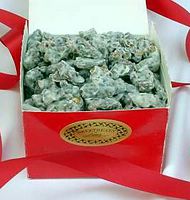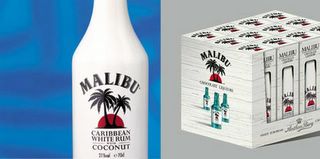"MALIBU ROCKS" Crushed In TTAB 2(d) Opposition
Pro se Applicant Lattis R. Richards wiped out in her attempt to register the mark MALIBU ROCKS for "white chocolate covered walnuts and pecans" (MALIBU disclaimed). The TTAB applied a formulaic DuPont approach in finding a likelihood of confusion with Opposer's mark MALIBU (registered in block-letter and design form) for "liqueur." Allied Domecq Spirits & Wine USA, Inc. v. Richards, Opposition No. 91116378 (January 25, 2005) [not citable].

Opposer also included in its notice of reliance a citation to a non-precedential TTAB decision. The Board pointed out that a party may not rely on such a decision for its statement of law. General Mills Inc. v. Health Valley Foods, 24 USPQ2d 1270, 1275, n. 9 (TTAB 1992). And since Applicant was not a party to the prior decision, that ruling could not be relied upon for its factual findings (under any claim preclusion or issue preclusion theory).
Ms. Richards, who operates out of Reseda, California, under the trade name "SWEETREATS BY LATTIS," took no testimony and offered no admissible evidence. In her brief, she argued that the term ROCKS will be seen as referring to "pebbles strewn on the beaches of Malibu," while Opposer contended that ROCKS would be perceived as meaning "ice," as in the term "on the rocks" used in preparing alcoholic drinks. The Board perceptively observed:
"We disagree with opposers insofar as it is highly unlikely that any consumer of applicant's goods would think of ice cubes when contemplating the mark MALIBU ROCKS used on or in connection with chocolate covered nuts."In any event, the Board concluded that the marks are both "evocative of a particular place in California," and have "very similar" commercial impressions.
Allied Domecq proved that its liqueur has been extensively advertised and widely sold as an ingredient in cocktails. While the Board did not find the mark to be famous, the evidence was "more than sufficient to prove the mark to be strong and distinctive."

Applicant Richards admitted that her product "contains a rum flavor [but no rum per se] in a wonderful orange marinade." And the Board carefully noted that:
"while applicant's product may be considered more a nut product than a chocolate product, it is still a product made by combining various ingredients and flavorings, as with confectionery products that do include a liqueur as an ingredient."Although Ms. Richards argued that her products are sold only as a gourmet or gift item, in outlets different from those for MALIBU liqueur, the Board once again noted that its determination must be based on the identification of goods in her application, which has no limitation on channels of trade, and not on the real world situation.
The Board concluded that, in light of the similarity of the marks, the overlap in prospective customers and channels of trade, and the probability that "consumers would likely assume some relationship as by licensing, common sponsorship or authorization by opposers for applicant to use opposers' mark," confusion of consumers is likely.
This writer finds the Board's decision less than convincing. Frankly, I find quite plausible Applicant Richards' assertion -- given the shape of her product -- that the mark MALIBU ROCKS for chocolate covered nuts would bring to mind pebbles or rocks on Malibu Beach. Perhaps its time to add a 14th factor to the Board's DuPont likelihood of confusion analysis: common sense.
Text ©John L. Welch 2005. All Rights Reserved.




0 Comments:
Post a Comment
<< Home